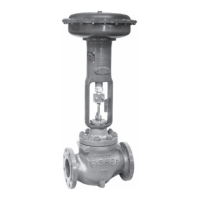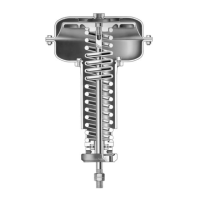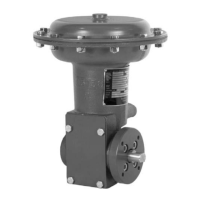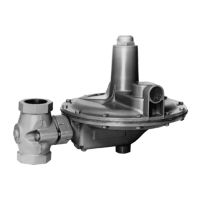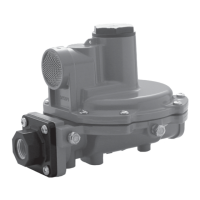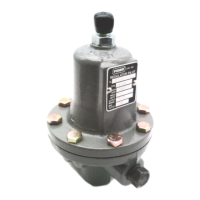2502 Series Controllers
Instruction Manual
Form 1446
November 2006
15
Startup
Adjustment locations are shown in figure 9.
1. Set the RAISE LEVEL control to the desired
control point as determined in prestartup checks
step 4.
2. Set the percent proportional band control to 200.
3. Set the reset control to .05 minutes per repeat.
4. Slowly open the downstream and upstream
manual control valves in the pipeline and close the
manual bypass valve if one is used.
5. With the controller set at the desired control point,
narrow the proportional band until a cycling condition
exists. Then broaden the proportional band slightly
until stable control is obtained.
6. Adjust the reset control to obtain the highest reset
setting without introducing cycling.
7. To ensure that the optimum proportional band
and reset settings have been obtained, momentarily
create a load upset. If cycling occurs, broaden the
proportional band slightly and repeat the load upset
until stability is attained. In general, the narrowest
proportional band and the highest reset setting that
will not produce cycling will provide the best control.
Principle of Operation
All 2502 Series controllers use the same basic
pressure-balanced relay with a yoked
double-diaphragm assembly (figure 10). This relay is
connected so that supply pressure is fed to the inlet
side of the relay valve and to the fixed restriction.
From this restriction, the air pressure goes into the
relay chamber on the side of the large diaphragm,
and to the nozzle. As long as there is no pressure
change on either diaphragm, the relay valve remains
in equilibrium with both the inlet and exhaust ends
closed.
The area ratio of the large diaphragm to the small
diaphragm is 3 to 1. A 0.8 bar (12 psig) pressure
change on the small diaphragm need only be
balanced by a 0.3 bar (4 psig) change on the large
diaphragm.
A change in liquid level, interface level, or density
changes the buoyant force exerted on the sensor
displacer, which in turn imparts a rotary motion
through the torque tube shaft. The rotary motion is
applied to the controller, which uses a nozzle,
bellows, and pneumatic relay to convert the rotary
motion to a standard pneumatic output signal. The
output signal is sent to a final control element. In
conjunction with this control element, 2502-249
Series controller-sensors are capable of bringing the
controlled variable back to a specific control point all
the time.
The following descriptions show how the relay works
in conjunction with the standard
proportional-plus-reset controller, and how the
differential relief valve construction works.
Type 2502 Controller
As long as inflow and outflow of the vessel are
equal, the beam and flapper remain motionless and
allow supply pressure to bleed through the nozzle as
fast as it enters the relay through the fixed
restriction. A level or density change either raises or
lowers the displacer and pivots the beam and flapper
with respect to the nozzle.
An increase in level or density with direct action, or a
decrease with reverse action, moves the beam and
flapper closer to the nozzle and restricts the escape
of supply pressure. This builds up the loading
differential on the side of the large diaphragm and
opens the relay valve to supply pressure inflow.
On the other hand, a decrease in level or density
with direct action, or an increase with reverse action,
moves the beam and flapper away from the nozzle
and permits supply pressure to bleed through the
nozzle faster than it can enter through the fixed
restriction. This builds up the loading differential on
the side of the small diaphragm, and opens the relay
valve to exhaust loading pressure.
The three-way proportional valve can be opened and
adjusted to allow some or all of the output pressure
change to feed back to the proportional bellows in
order to change the proportional band of the
controller. This pushes the beam and flapper
opposite the way it is being pivoted by the torque
tube shaft, counteracting the pressure change in the
nozzle and again stabilizing the relay diaphragm
pressure differential. The relay valve shuts off and
maintains a new output pressure according to the
change in sensed displacer position.
A wide-open proportional valve permits feedback of
all the output change and produces 100 percent
proportional response. Closing of this valve
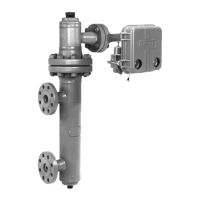
